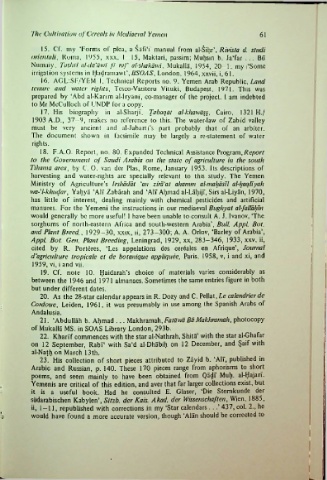Page 75 - Arabian Studies (I)
P. 75
The Cultivation of Cereals in Mediaeval Yemen 61
15. Cf. my ‘Forms of pica, a Safi‘f manual from al-Sihr’, Rivista d. studi
oricntali, Roma, 1955, xxx, 1 15, Maktari, passim; Muhsin b. Ja‘far ... Bii
Numaiy, TashTl al-da'awl JT raf al-shakawl, Mukalla, 1954, 20 -1; my \‘Somc
irrigation systems in Hadramawt’, BSOAS, London, 1964, xxvii, i, 61.
16. AGL:SF/YEM I, Technical Reports no. 9. Yemen Arab Republic, Land
tenure and water rights, Tcsco-Viziteru Vituki, Budapest, 1971. This was
prepared by ‘Abd al-KarFm al-IryanF, co-manager of the project. I am indebted
to Mr McCulloch of UNDP for a copy.
17. His biography in al-SharjF, Tabaqat al-khawass, Cairo, 1321 H./
1903 A.D., 37—9, makes no reference to this. The water-law of Zabfd valley
must be very ancient and al-Jabartfs part probably that of an arbiter.
The document shown in facsimile may be largely a re-statement of water
rights.
18. F.A.O. Report, no. 80. Expanded Technical Assistance Program, Report
to the Government of Saudi Arabia on the state of agriculture in the south
Tihama area, by C. 0. van der Plas, Rome, January 1953. Its descriptions of
harvesting and water-rights arc specially relevant to this study. The Yemen
Ministry of Agriculture’s Irshadat ‘an zira'at ahamm al-mahasll al-haqliyah
wa-'l-khudar, Yahya ‘A1F Zabarah and ‘A1F Ahmad al-Lahijf, Sirs al-Liyan, 1970,
has little of interest, dealing mainly with chemical pesticides and artificial
manures. For the Yemeni the instructions in our mediaeval Bughyat al-fallahln
would generally be more useful! I have been unable to consult A. J. Ivanov, ‘The
sorghums of north-eastern Africa and south-western Arabia’, Bull Appl. Bot. I
and Plant Breed., 1929-30, xxix, ii, 273-300; A. A. Orlov, ‘Barley of Arabia’,
Appl. Bot. Gen. Plant Breeding, Leningrad, 1929, xx, 283-346, 1933, xxv, ii,
cited by R. Porteres, ‘Lcs appelations des cereales en Afrique’, Journal :
d'agricullure tropicale et de botanique appliquee, Paris, 1958, v, i and xi, and
1959, vi, i and vii.
19. Cf. note 10. Haidarah’s choice of materials varies considerably as
between the 1946 and 1971 almanacs. Sometimes the same entries figure in both
but under different dates.
20. As the 28-star calendar appears in R. Dozy and C. Pellat, Le calendrier de
Cordoue, Leiden, 1961, it was presumably in use among the Spanish Arabs of
t
Andalusia.
21. ‘Abdullah b. Ahmad ... Makhramah, Fatawa Ba Makhramah, photocopy
of Mukalla MS. in SOAS Library London, 293b.
22. KharFf commences with the star al-Nathrah, Shita’ with the star al-Ghafar
on 12 September, RabT with Sa‘d al-Dhabih on 12 December, and Saif with
al-Nathon March 13th.
23. His collection of short pieces attributed to Zayid b. ‘A1F, published in
Arabic and Russian, p. 140. These 170 pieces range from aphorisms to short
poems, and seem mainly to have been obtained from QadF Muh. al-HajarF.
Yemenis are critical of this edition, and aver that far larger collections exist, but
it is a useful book. Had he consulted E. Glaser, ‘Die Stemkunde der
siidarabischen Kabylen’, Sitzb. der Kais. Akad. der Wissenschaften, Wien, 1885,
ii, 1 — 11, republished with corrections in my ‘Star calendars ...’ 437, col. 2., he
would have found a more accurate version, though ‘Alan should be corrected to
•j

